Table of contents
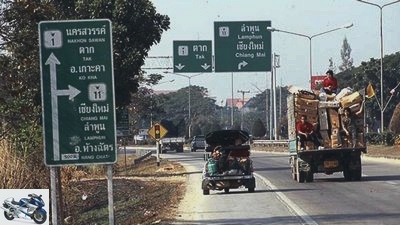
Henniges
to travel
On the way: Adventure story Thailand
Traveling
Adventure in Thailand: traveling with a tuk tuk
It is 783 kilometers from Chiang Mai to Bangkok. That corresponds to 13 hours of train travel or 50 minutes of flight time. Editor Rolf Henniges took 75 hours – with the tuk tuk, a three-wheeled taxi.
Rolf Henniges
05/11/2009
He is wearing a blue shirt that is three sizes too big. His lips bare a yellow-brown, patchy parade of teeth. “No problem,” he repeats for the umpteenth time and smiles obscurely. Of course he could drive the tour, no problem. His vehicle is excellently equipped for this: tires that never go flat, fuel that practically never runs out, a driver who knows his way around very well and certainly does not run out of steam. In addition, he emphasizes at the end of every second sentence, he has the necessary “experience”. Would have done the trip over ten times.
Buy complete article
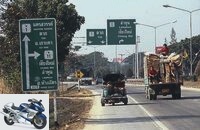
Traveling
Adventure in Thailand: traveling with a tuk tuk
10 pages) as PDF
€ 2.00
Buy now
Thongtherm Chabchinda is an estimated 50 plus. He is married and has two sons. His hair sticks haphazardly to his skull, his eyes shimmer reddish. He speaks broken English and smokes homemade rolls. Mister Chabchinda is a tuk tuk driver in Chiang Mai, Northern Thailand, and he assures us that he will drive us to Bangkok International Airport – around 780 kilometers direct.
We both, my friend Rocky and I, must be crazy. This is confirmed by the reactions of many tuk tuk drivers we asked. Every time we said the destination and the drivers realized we were serious, their forehead creased and they slowly shook their head. No, that’s crazy. There are too many reasons not to go on this trip from Chiang Mai to Bangkok.
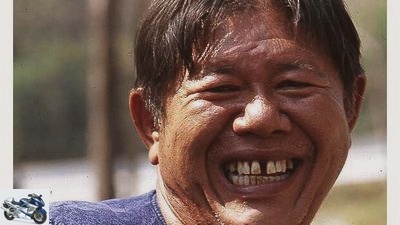
archive
Mister I-make-everything-possible: Thongtherm Chabchinda.
First: Tuk Tuks registered in Chiang Mai are not allowed to operate outside the city limits. Second: The engines are only designed for short journeys; they die in heat on long journeys. Thirdly, there are no tuk tuks in any city between Bangkok and Chiang Mai, so there are no special petrol stations. And the engines need LPG gas. Fourth: Almost all drivers are from Chiang Mai or the surrounding northern provinces. Most of them cannot read, cannot find their way around, and are happy to survive a day in Chiang Mai’s traffic chaos. Bangkok as a destination? We could also have specified Paris. The start is to take place at 9:00 a.m. the following day. Mister Thongtherm Chabchinda, or Chinda for short, wants to pick us up on time. He called for a day to prepare himself and the tuk tuk.
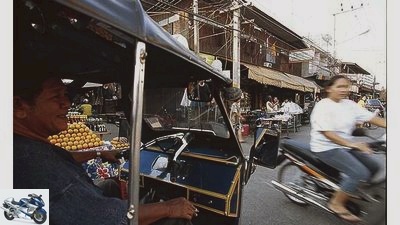
archive
Daily chaos in the small towns: the hustle and bustle of people, no signposts, ask for the route.
It’s one of those mornings in Chiang Mai when the sun hugs your body like a microfiber blanket. The light north wind has wiped the hot breath of the 300,000-strong metropolis from the streets. At exactly 8:57 a.m., Chinda’s Tuk Tuk turns into the hotel entrance. His vehicle is blue metallic, bears the number 416, has about 15 years under its belt and has unwound 244052 kilometers. Maybe 100,000 more. It is powered by a Suzuki three-cylinder engine with 800 cubic capacity, which makes a benevolently estimated 22 hp. It is braked by two 250 millimeter brake drums mounted on the rear axle. A motorcycle fork at the front and two leaf springs at the rear take care of the suspension. The passengers sit on a bench covered with plastic film, seating area 35 by 100 centimeters. Chinda is wearing the blue, wide shirt from the day before. Five plastic bags dangle from the sides of his tricycle. Provisions for the next three to four days: four kilograms of oranges, two rolls of toilet paper, three liters of engine oil, dozens of wrenches, one liter of brake fluid.
Two gas bottles are provisionally attached to the luggage rack behind the passenger seats with thin ropes. A rear-end collision would have fatal consequences. The large one holds 16, the smaller eight liters. They are connected to the 20 liter vehicle tank with a garden hose and hose clamps. Open the tap, then the motor sucks its additional vespers through this construction. “No other Tuk Tuk can go so far,” smiles Chinda, “I have experience. Trust me, cause it’s my life too, har har.”
An hour later: Apart from ours, no other tuk tuk can be seen on the street. 80 km / h feels like 250 in our vehicle. Chinda stops on the side of the road and takes a smoke break. When he tries to start again, the old engine refuses. Only after the 18th attempt does he reluctantly start work. We have covered 30 kilometers so far. There are still around 700 to Bangkok. “No problem, says Chinda. The engine is like his wife. He understands that brilliantly. He just bitches around every now and then, but doesn’t mean it that way.
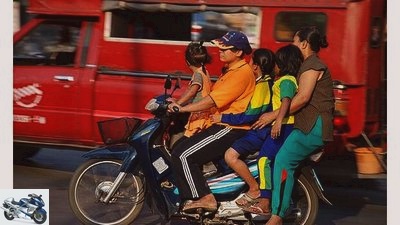
archive
Well, please, it works: a Honda Dream in normal use.
Three minutes and three kilometers later there is a smell of cooling water. It’s hot, 36 degrees outside, the sun hangs in the sky like a big yellow Gouda. We slow down. Chinda holds up her nose, sniffs. Serious Problem? “No mister”, laughs our chauffeur. It is nothing more than a mechanical fart. He ignores the sweet-tart smell that creeps out of the bowels of our vehicle like a warning and continues the journey on the dead straight route.
The wind is like a hair dryer, burning the moisture from the nasal mucous membranes and eyes. The road is brownish-black piebald. Brake fluid, oil and cooling water have colored the tar over the years, giving it an unmistakable patina. Depending on the season, dust, exhaust fumes and smoke hang in the air. There is hardly any air circulation. We’re driving under a haze. Some of the surrounding hills and mountains can only be guessed at, as if they were carved out of a piece of shadow. Earth and horizon blur into an ash-gray sadness.
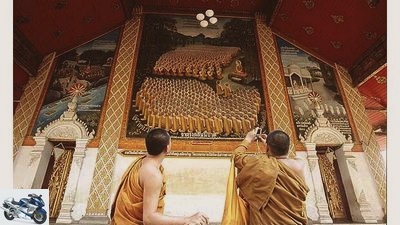
archive
Modern times: monks with cell phones, sneakers and cameras.
In the early afternoon we stop in Lamphun, a tranquil small town with 25,000 inhabitants and the complex temple complex Wat Chan Haripunjai, the construction of which began in 1044. Haripunjai houses dubious monks. Dubious for European expectations. They talk on the phone, take photos, wear sunglasses and Nike trainers. Like Chiang Mai, the 1,300-year-old city is surrounded by a moat that was used for defense. The stop in Lamphun is short, the vastness of the north and the federal road 1147 captivates us again.
Two smoking breaks and 30 minutes later we reach the foot of a ridge that marks the border between Chiang Mai and Lampang. Chinda shifts back from fourth to second gear. The TT is fighting an estimated 20 percent incline, gasps, sweats, groans. In front of and next to us: soot-throwing trucks in crawling gear. Hardly faster than a pedestrian, dragging a cloud behind him like James Bond, when he wants to shake off his pursuers. We pass an elephant camp on the side of the road, pachyderms doze off in the afternoon heat, suddenly it goes steeply downhill. The tar ribbon meanders down the hill like a ribbon of rhythmic gymnasts. “Easy 100, Chinda yells against the wind and points to the speedometer,” Easy, easy!” We lurch. Worn tires, worn out wheel guidance, brakes with a more than dubious effect. 40 kilos of luggage, 90 kilos of driver, 150 kilos of front passenger and around 40 liters of propane gas – that could leave a huge crater on impact.

archive
Markets along the way: there is everything from dried maggots to painted condoms.
But it’s going well. Overjoyed to have reached Lampang, we check into the first hotel we come across: the double room costs 350 baht (seven euros). Instead, there are cables torn from the wall, the bathtub is a mold paradise, the interior is worn and worn out, the mattress is damp and saggy.
In such establishments you get it served, the Asian sound cocktail. If you don’t stay mainly in spa resorts or high-priced hotels, you will notice that not only Thailand’s capital Bangkok is the “City that never sleeps” is. Silence is truly the very last thing you will find here. Instead: rebellious dogs, screeching sirens, noisy, half-broken air-conditioning systems, annoying screeching, deafeningly loud televisions, slamming doors, squabbling taps, roaring karaoke bars and non-stop traffic until midnight. On every street, in every little alley.
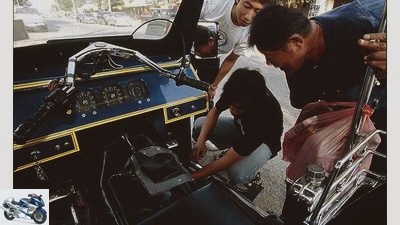
archive
“Return spring torn from the accelerator?” “Doesn’t matter, then you just go full throttle!”
Friday morning, 9.15 a.m .: We barely drove a few hundred meters when Chinda gets a bit hectic. “I need only half an hour,” he says. The brake pedal return spring is broken. Only the fifth of the workshops approached is dedicated to the job. The other four reject him with flimsy excuses. “Too busy, they explain. The more likely reason: You are scared. Tuk Tuks are only known here from television, the mechanics are afraid of exposing themselves to repairs.
Around ten o’clock we continue our trip with our tricycle, following the seemingly endless lead-gray tar ribbon that is supposed to lead us to the city of Tan. Power cables drag themselves over inclined masts along the road, connecting even the smallest of towns with the electrical nerve of civilization. The landscape stretches around the sides of our cabin: lime green sugar cane fields, fallow and harvested rice plantations. Diffused, as if three-year-olds had tried to design an oversized checkerboard pattern. In the middle there are Spartan shelters, consisting of a covered platform to sit on, one meter above the ground.
We glide along at a steady 80 km / h. Words are shredded by the wind. The sound of the journey is like a waterfall, made up of the roar of the airstream and the incessant rhythmic tak-tak-tak of the rear wheel axle when the wheels bob over the concrete sleepers of the roadway. The chirping of the plastic bags in which Chinda has stowed his provisions, with which the airstream plays with. The uninterrupted aaahhh of the squawking two-stroke engine, the furry rolling noise of the tires. Interrupted by a sudden hiss when brand new mid-range sedans shoot past us with enormous excess speed. Or a bow wave of wind from the trucks that overtake us on the straight or on a downhill slope.

archive
Tip in the corner of your mouth and open the gas bottle.
Trucks whose drivers, thanks to their talent for improvisation, manage to load every 7.5 ton truck with at least ten tons. The goods were secured with twine to prevent them from falling, engines dripping with oil, poorly repaired, chassis with wobbly wheels, as if they were about to fall off in the next few seconds. Trucks whose drivers are tired, drunk and poorly trained. You don’t need a driver’s license in Thailand. The main thing is that you can drive. Six-axle articulated trucks, compared to which the tuk tuk looks like a toy. Thais live and drive in trust in God. A conscientious German TuV official would succumb to a heart attack here ad hoc.
Hardly twenty minutes driven through the parched wasteland, the tuk tuk rolls to the side of the road. Our chauffeur lights a cigarette, calmly walks back, swings under his taxi and opens the ten-liter gas dump. It hisses – pressure equalization between bottle and tank. We dive for cover and hope that the garden hose is tight. Chinda takes a leisurely draw on his cigarette and smiles. “Easy”, he says, “trust me.”
Adventure story Thailand part 2

archive
Suspension bridge over a branch of the mighty Chao Phraya.
The landscape changes its face between Tak and Kamphaeng Phet. The highway leads us through a green valley floor, escorted by mountains that can only be guessed at. Through a delta, lined with fertile rice fields, palm trees like thick bushes – we are in the realm of the Ping River. Swirling mist hangs over the river like a wet, heavy sack. Majestically serene, he pushes himself forward under a seemingly endless bridge. The powerful, moist vein is a guarantee of life even in extremely dry years like this one. Surrounded by huge rice plantations, reeds and jungle, it makes its way south.
We remain loyal to the highway and in the area of influence of the Ping River. Huge rice plantations line the way to Nakhon Sawan. South of the city, the four rivers Ping, Wang, Yom and Nan unite to form the mighty Chao Phraya. Our modest room at 350 baht (seven euros) in the Peng Nueng Hotel is not only identical in price to that of the previous night. In the middle of the room are two chairs, each with one leg missing. The mattresses, saggy, damp, rest on a thin steel mesh that gives way even with the slightest pressure. Completely tattered frames frame a door that does not close properly.
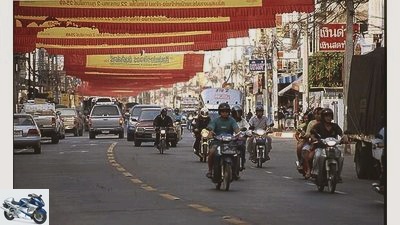
archive
Asia is mobilizing: traffic and sea of flags in Nakhon Sawan.
A sea of flags billows over the main street. Yellow and red flags stretch between the canyons to announce the Chinese New Year. The new morning is brimming with activity. But no trace of the hectic pace. The street overflows with vehicles of all kinds, rolling through the canyon of houses like a slowly cooling lava flow. Thailand has no road traffic licensing regulations. Anyone who is skillful, can tinker with something that somehow moves forward, in the best case can also transport a lot, will do it too. Many small mopeds are provided with adventurous welded sidecars. Brakes? Does not matter. Lighting? What for?
The highway has four lanes, a ten meter wide, funnel-shaped strip of lawn separates the two lanes for each direction. It’s like walking on an ant road. We count three serious accidents in the first 25 kilometers between Nakhon Sawan and Chainat. The main causes: technical defects or truckers who fell asleep. Despite taking drugs or consuming little pick-me-ups like Lipovitan – a drink available at every petrol station that contains a few vitamins, but mainly caffeine and a codeine derivative.
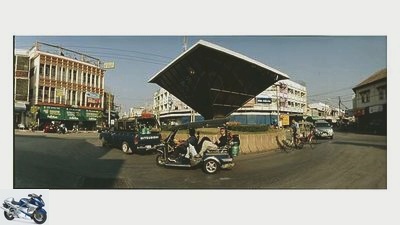
archive
So much for wearing seat belts, side and front airbags, ABS and general safety.
Here the devil is challenged every second. The temporarily attached cargo sways and bounces with every stroke of the leaf springs, every bump. The road is full of holes, unsecured and paved with fallen parts or run over dogs. At the center of the traffic anarchy: the moped drivers. With bare arms and legs, unprotected from sunlight, insects or falls. With their mobile phones in one hand and text messages, they spin around the trucks, cross the lanes, zigzag as if they were about to complete a training course. An estimated twenty million two-wheelers cavort on the streets of Thailand. 80 percent of the accidents with around 13,000 road deaths are involved in motorcyclists. For six years, former Prime Minister Thaksin Shinawatra tried in vain to enforce the existing helmet requirement with fines. Driving without a helmet costs 500 baht (eleven euros) fine. Nevertheless, more than half continue to ride without a helmet. Controls are rare and hardly feasible outside the cities due to the lack of officials.
The landscape that passes by is bizarre, because it is absolutely controversial: the rice farmers’ small shelters are surrounded by huge high-voltage lines that transport energy into the distance. Poorly dressed men with hundreds of pounds on their shoulders versus the latest generation of pick-ups with ESP, ABS, Klimatronic, parking aid and side airbags. Horsepower-splitting tractors alongside donkey and horse-drawn wagons, 100-square-meter billboards compete with self-scribbled signs in the small food stalls along the street. Thailand is a mixed country. A country in which the average income of craftsmen is 8,000 baht (165 euros) a month, the beer has 6.4 percent alcohol, the liter of premium gas costs as much as a Big Mac (75 cents) and prostitution is part of everyday life like Aldi to Germany. A controversial country. On the one hand the highways, the busy cities or the tourist enclaves. On the other hand, there are the many small towns that are barely fed by the main artery of civilization.
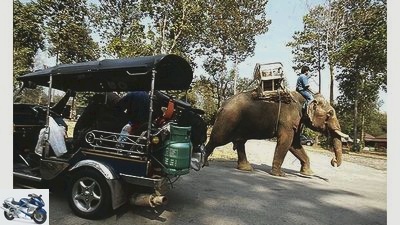
archive
Picturesque and characteristic Thai cliche: tuk tuk and working elephants.
At the height of Phayuha Khiri Chinda rolls off the main road, we almost collide with a truck. Our journey ends after two kilometers in front of the cookshop of an old woman who sells noodles and rice from her living room. Here the nerve seems to have been cut in modern times. A randomly laid electrical cable feeds an ailing, completely rusted refrigerator, a couple of lightbulbs and a portable radio with energy branched off somewhere. An electrical jumble that is hard to believe, that anything still works when it rains. Wooden living barracks border the courtyard, covered with corrugated iron, bare ground inside, not insulated against cold and damp, instead of windows, glass-free recesses. Wooden frames with straw and thin blankets serve as beds. The four by four meter room is shared by a family of eight with a few chickens, geese and goats. In this environment it is difficult to believe the year on the calendar with the portrait of the king of Bhumibol Adulyadej, which is present everywhere: 2009.
They are places without a lot of color. Brown earth, gray facades, dark-skinned people in modest clothes that have been washed a thousand times, boards bleached by the sun, yellowed, dead trees. Places where the yellow bike of a five-year-old looks as integrated, like a coke can that you would find on the first landing on Venus. Just as out of place: the ultra-modern hairstyles as well as bizarrely pepped up small motorcycles or TVs that flicker in continuous operation. Despite the 24-hour shower of daily soaps and news, the rate of awareness about AIDS or bird flu is low. If you live in structural conditions that have remained practically unchanged for 200 years, it is almost impossible for you to understand that chickens are suddenly dangerous or that sexual intercourse is risky. She heard about it, the cook admits, and slaughtered a chicken on the side. The danger lurked out there somewhere, probably in America. But how is it to be put in relation to each other? The cook doesn’t want anyone to tell her where to send her chickens to sleep. Ultimately, the neighboring state of Laos seems to be just as far away for many Thais as the USA or New Zealand.
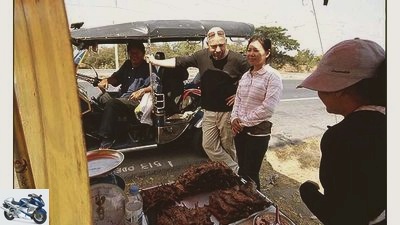
archive
Fried rats for in between: grill stand for truckers.
20 kilometers from Chai Nat, Chinda targets a parking lot where a bunch of truckers are crowding around a small sales stand. Two women offer grilled rats, one kilogram for 130 baht (2.70 euros). The animals seem particularly popular with truckers. Chinda describes the taste as “like that of a particularly tender chicken”. We taste timidly. He’s right. Within ten minutes, the two women sell 27 specimens and explain the origin of the animals to us: Chainat is considered the capital of rice cultivation. 50 percent of the total Thai production comes from the area. The rats feast on the seeds, are caught in traps by the rice farmers and delivered to the two women. These gutt the rats, skin them and sell them. There is a freezer on the saleswoman’s pickup, which is supplied by an emergency generator. It is full of frozen rodents, divided into three sizes and bundled into handy packages of one kilogram each – for the barbecue party at home.
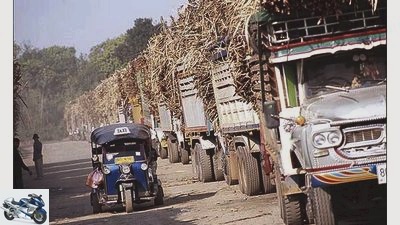
archive
Traffic jam in Thai: trucks are waiting to be allowed to unload their freight in the sugar factory.
We cover the route between Chainat and Ayutthaya on side streets peppered with curves, which Chinda always takes on the ideal line without even being able to see them. Huge, partially harvested sugar cane plantations dominate the expanse and have displaced rice cultivation. Hundreds of trucks, loaded as high as two-story houses, transport the goods to the factories and queue at their gates. After Brazil, India, China and the USA, Thailand is the world’s fifth largest sugar producer with around 7.5 million tons. The streets are covered with fallen, tattered stalks that whirl up behind the tuk tuk as if they wanted to obliterate our trail forever.
Ten kilometers before Ayutthaya, haze begins to rule the atmosphere. The rivers Chao Phraya, Lopburi and Pa Sak wind around the village of 60,000 souls. The air is heavy, sweet, musty. A sea of flags is blowing in the city, the Chinese New Year is being celebrated on a large scale, around 20,000 visitors have come to see it. We wander through overcrowded streets and alleys and only find a few vacant rooms after a two-hour search.
In terms of accommodation, the Mai Thai Hotel is the absolute low point of our tour: glassless windows, tattered mosquito nets, cupboards without doors and intermediate floors. In addition, as cleanly as if they had been built centuries ago and have not been swept since then. This patina of indifference casts a bad light on the city, which was the capital of Siam for around 400 years from 1350 and is reportedly the most impressive city in Asia. In 1767 it was almost destroyed by the Burmese and is now an insignificant provincial town that adorns itself with the remains of the past.
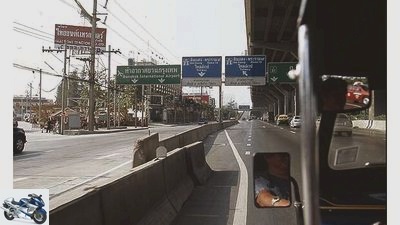
archive
Last stop after four crazy, adventurous days: arrival at Bangkok airport.
Sunday morning. Only 100 kilometers separate us from Bangkok Airport, which we want to cover as quickly as possible. Despite the holiday, the highway is flooded with vehicles of all stripes. Its road surface, which resembles that of a Swiss cheese, deals nasty blows. The leaf springs of our Tuk Tuk give up in the face of these attacks. The suspension of the passenger bench breaks, we are shaken like bullets when drawing the lottery numbers. Our vehicle feels like it has aged 20 years in the last three days. “No problem”, Chinda yells against the noise, “I’ve everything under control “.
Industrial plants and shops rush past to the right and left every second. The way – actually designated as a highway – seems to be a tentacle of the eight million Moloch Bangkok. In the city of 400 temples, well over two million vehicles torment their way through the congested streets. Soot cannonades and exhaust gas bombardments attack us. Now it becomes clear why every fourth person here wears respiratory protection. Around 11.15 a.m., the concrete and tar snakes on which we drive expand and become increasingly daring, the forest of signs becomes confusing, Chinda more and more nervous and insecure. “17 Years ago, I was in Bangkok the last time, he says. “Everything changed.” Well it’s out. Our driver cheated on us. The last time he drove this route was ages ago, maybe even on the train. He had no experience at all.
It borders on a miracle that we have not been involved in a collision in the last few minutes, because only now is something we have suspected for a long time through his sneaking up on signs and zigzagging: Chinda sees poorly, recognizes signs and signposts only in the last few meters. Our driver trusted his seventh sense from the start. And it doesn’t seem to work that well here in Bangkok. Anyway, at exactly twelve o’clock, after exactly 75 hours, we are standing in front of the terminal of Bangkok airport. The taxi and tuk tuk drivers present crowd around Chinda, whose license plate provides information about his origin. “800 kilometers – you have to be crazy, they call and pat him on the shoulder, impressed.
Chinda is overjoyed. He laughs, puts the other half of the agreed amount in the pocket of his blue shirt fluttering in the wind, which he has not changed during the entire trip, and shakes his head: “Crazy”, he chuckles again and again, “totally crazy, har, har, har.”
We’re not sure who he means. Us or him.
Info
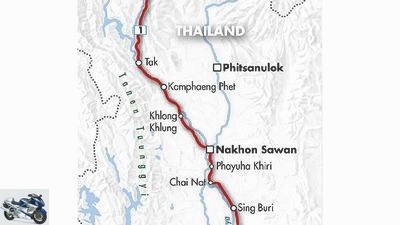
archive
783 kilometers with the tuk tuk – a mad trip over 4 days, for which the driver demanded an outrageous 1000 euros, but was negotiated down to 500 euros.
Interesting facts about tuk tuks. In many Asian countries, three-wheeled taxis are part of the street scene. The Thailand Tuk Tuk, a one-off manufactured in Bangkok since the mid-1960s, has achieved worldwide fame through feature films and postcards. Around 7,500 tuk tuks are registered in Thailand’s capital, of which 4,000 to 5,000 are in daily use. Only two percent of the drivers are owners at the same time. Most of them rent their vehicles (350400 Baht / day in BKK, 150-200 Baht / day in Chaing Mai) from large companies organized like forwarders. The crude mix of motorcycle at the front and car at the back provides an adventurous transport experience that you should definitely experience once despite various hazard warnings in relevant travel guides. First rule: negotiate the price BEFORE you start your journey. Those who don’t care about the feeling should get into an air-conditioned taxi cab, especially in Bangkok – it’s often even cheaper than the tuk tuk. Prospective buyers have to estimate around 80,000 baht (1,660 euros) for a roadworthy tuk tuk without registration. If you want to allow it for the taxi operation, you pay another 170,000 baht (3540 euros) fees to the state.
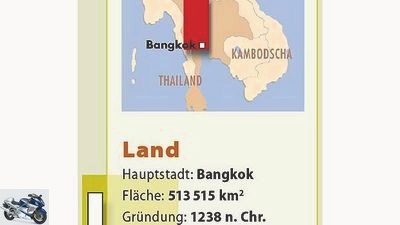
archive
Brief information about Thailand
Like in Bangkok There are also mafia-like agreements in Chiang Mai between TT drivers and nightclub owners, boutiques, tailors or jewelers. Inexperienced tourists are lured into a tour of the city with dumping prices (for example, driving all day for only ten baht), and then driven from shop to shop. Regardless of whether the tourist buys or not, the chauffeur receives a “towing sum” from each business owner” (in Bangkok 200 baht). At night, the tuk tuk drivers receive 20 percent of the entrance fee or the amount for the love service for every customer or guest delivered to the sex shows, which are notorious for the country.
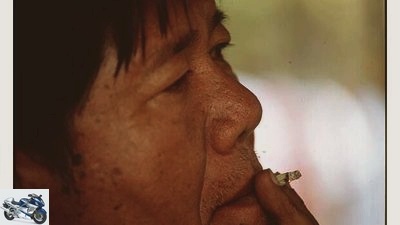
archive
The tuk tuk driver Thongtherm Chabchinda, or Chinda for short, doing one of his main occupations: smoking.
Thongtherm Chabchinda, is actually 61. In his ID card, however, 56 are entered – because of the insurance, as he says. Mr. Chabchinda is one of around 4,000 tuk tuk drivers in Chiang Mai. He speaks mediocre English, fluent Chinese, has a degree in politics and previously worked for an insurance company. Born in Bangkok, he has been driving tuk tuk for 15 years and is the father of two adult sons, the youngest of whom is also a tuk tuk driver. The diabetic with the life motto “Everybody is born to die” drinks a liter of beer a day and smokes at least one packet of tobacco with it. His longest trip so far was a 100-kilometer round trip around Chiang Mai, which two Englishmen had booked for 2000 Baht. He puts the normal wage on the streets in Chiang Mai at 1000 to 1500 Baht on a ten-hour working day. From this, 160 baht tuk tuk rental and the cost of a full tank (350 baht) are deducted.
Related articles
-
Motorcycle tour in Northern Thailand
Jo Deleker 36 pictures Deleker 1/36 Traveling by motorcycle in Northern Thailand. Deleker 2/36 Traveling by motorcycle in Northern Thailand. Deleker 3/36…
-
Motorcycle tour through Albania: it remains an adventure
Tummescheit to travel Motorcycle tour through Albania: it remains an adventure Motorcycle tour through Albania It remains an adventure Albania welcomes…
-
Pendulum test of KTM Adventure models
jkuenstle.de 45 pictures KTM 1/45 January 2013: It is already clear at the presentation – the new KTM is a great success. markus-jahn.com 2/45 July 2013:…
-
MSC cornering ABS in the test in the KTM 1190 Adventure
Jahn motorcycles MSC cornering ABS in the test in the KTM 1190 Adventure MSC in the KTM 1190 Adventure put to the test ABS suitable for lean angles…
-
archive 19th pictures archive 1/19 The neverending MZ story: DKW RT 125. archive 2/19 MZ died on installments. Now the inheritance is still being haggled…
-
On the go: Enduro adventure on the Baja California
Angry 17th pictures Angry 1/17 … and last but not least, the local people’s dignified culinary skills. Angry 2/17 With a swing through sand passages -…
-
On the way through the jungle of Thailand
Iron ham 21 pictures Iron ham 1/21 Even a small-volume enduro is enough to experience driving fun and typical exoticism on Thai jungle slopes and asphalt…
-
The endurance test of the KTM 790 Duke Adventure R
KTM motorcycles Enduro The endurance test of the KTM 790 Duke Adventure R KTM 790 Duke Adventure R in the intensive test Is it the most off-road daily…
-
Adventure travel – enduro riding in Croatia
Igor Spajia 14th pictures Tijac 1/14 Igor Spahija is one of the makers of Šibenik Adventure. The prices depend on the season. Spahija 2/14 The south of…
-
to travel Thailand Thailand Travels in 2543 No, this is not a vision of the future; 2543 is the year 2000 – according to the Buddhist calendar. But…